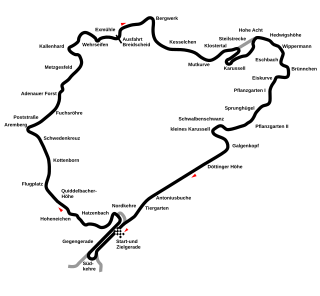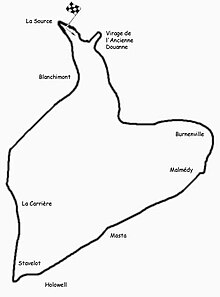
Tazio Giorgio Nuvolari was an Italian racing driver. He first raced motorcycles and then concentrated on sports cars and single-seaters. A resident of Mantua, he was known as 'Il Mantovano Volante' and nicknamed 'Nivola'. His victories—72 major races, 150 in all—included 24 Grands Prix, five Coppa Cianos, two Mille Miglias, two Targa Florios, two RAC Tourist Trophies, a Le Mans 24-hour race, and a European Championship in Grand Prix racing. Ferdinand Porsche called him "the greatest driver of the past, the present, and the future."

Achille Varzi was an Italian Grand Prix driver.
Baconin Borzacchini was an Italian Grand Prix motor racing driver often referred to as Mario Umberto Borzacchini.

The 1935 German Grand Prix was a Grand Prix motor race held at the Nürburgring on 28 July 1935.

Guillaume Laurent "Guy" Moll was a French racing driver.

The Alfa Romeo P3, P3 monoposto or Tipo B was a classic Grand Prix car designed by Vittorio Jano, one of the Alfa Romeo 8C models. The P3 was first genuine single-seat Grand Prix racing car and Alfa Romeo's second monoposto after Tipo A monoposto (1931). It was based on the earlier successful Alfa Romeo P2. Taking lessons learned from that car, Jano went back to the drawing board to design a car that could last longer race distances.

Formula Libre, also known as Formule Libre, is a form of automobile racing allowing a wide variety of types, ages and makes of purpose-built racing cars to compete "head to head". This can make for some interesting matchups, and provides the opportunity for some compelling driving performances against superior machinery. The name translates to "Free Formula" – in Formula Libre races the only regulations typically govern basics such as safety equipment.

The 1931 Grand Prix season was a watershed year, with the advent of the AIACR European Championship. After several years of Grand Prix racing in the doldrums with little technical development, 1931 saw new models come from all three main manufacturers: Bugatti, Maserati and Alfa Romeo.

The 1932 Grand Prix season marked the second year of the AIACR European Championship. It saw the debut of Alfa Romeo's sensational new Tipo B and with it, Tazio Nuvolari won the Championship driving for the Alfa Corse works team. The 40-year old Nuvolari won two of the three rounds and was second in the other. Still running to a Formula Libre rules for the cars, the regulations were revised to set the races to be between five and ten hours. However, all three national committees ran their races to the minimum time-limit.

The 1933 Grand Prix season was an intermediate year, as it would be the last season for the current AIACR regulations before a new weight-formula was introduced in 1934. As such, the European Championship was not held and the manufacturers held back on further developments of their existing models. Alfa Romeo, following an Italian government financial bailout and like Mercedes-Benz the previous year, had shut down its Alfa Corse works team. Scuderia Ferrari, their regular customer team took up the role of racing Alfa Romeos and a number of ex-works drivers moved across to join their ranks. They were not allowed, however, to buy the impressive Tipo B that had been so dominant in the previous season.
The 1934 Grand Prix season saw the advent of the new 750kg Formula. In an effort to curb the danger of rising speeds, the AIACR imposed this upper weight limit that effectively outlawed the large capacity engines. The incumbent manufacturers Alfa Romeo, Maserati and Bugatti had been preparing their new models with varying success – the best of which was the Alfa Romeo Tipo B. However, it was the state-sponsored arrival of the two German teams, Mercedes-Benz and Auto Union, and their innovative and progressive cars that ignited a new, exciting era of motor racing.

The 1928 Grand Prix season saw the Monegasque driver Louis Chiron, and his Bugatti, take seven Grand Prix victories.

Luigi Arcangeli was an Italian motorcycle and car racer.
The 1929 Grand Prix season was another interim year, where most races were run to Formula Libre rules due to a lack of regulations from the AIACR that would be popular for race organisers and manufacturers. This blurred the line between racing cars and sports cars with both competing in the same races. Bugatti won the major international races, with their drivers Louis Chiron and "W Williams". The Italian Championship proved very competitive, attracting many top drivers. There it was Alfa Romeo, using their 4-year old P2 model that claimed more victories, than their main competition coming from Bugatti and Maserati.
The 1930 Grand Prix season continued the malaise that had taken over the sport. Although there was little technical advance more privateer teams were forming, getting some factory support. The AIACR continued to mandate its fuel-regulated Formula Libre rules. Across the Atlantic, the AAA abandoned the AIACR regulations. Their new regulations were derisively called the “Junk Formula” by purists, opening up to their own version of Formula Libre: with modified stock-standard cars of up to 366 cu in (6-litres) with two seats.

The Tunis Grand Prix or Grand Prix de Tunis was a motor race held in the 1920s and 30s in Tunis, the capital of the African colony of the French protectorate of Tunisia.

The 1930 Targa Florio was a non-championship Grand Prix motor race held on a 67 mile (108 km) course made up of public roads on the mountainous Italian island of Sicily.

The 1933 French Grand Prix was a Grand Prix motor race which was run on 11 June 1933, in Montlhéry, France. Organized by the French Automobile Club, it was XXVII running of the Grand Prix de l'Automobile Club de France. The race, which was held over 40 laps, was won by the Italian driver Giuseppe Campari in a privately entered Maserati. It was to be Campari's final victory, as he was killed just three months later at Monza. Philippe Étancelin and George Eyston, both in privateer Alfa Romeos, finished in second and third, respectively.

The 1933 Tunis Grand Prix was a Grand Prix motor race held at the Carthage Street Circuit in Tunis, the capital of colonial Tunisia, on 26 March 1933. Tazio Nuvolari won the 37 lap race, driving for Scuderia Ferrari, Alfa Romeo's works team, while his teammate, Baconin Borzacchini, finished second. Third place was taken by the privateer Maserati of Goffredo Zehender.
The Algerian Grand Prix or Grand Prix d'Alger was a motor race held in the 1920s and 1930s at several coastal road courses in the department of French Algeria.














